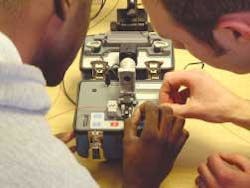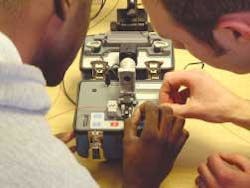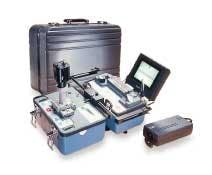The last several years have seen a dramatic increase in the bandwidth requirements in the data-communications market. Until recently, the datacom market had been dominated by copper cabling, but now optical-fiber solutions have become increasingly cost-effective and are now being used in many high-speed data networks.
In the past, many communications-cabling installers have chosen to subcontract fiber work to specialists. But as optical fiber is increasingly specified in data networks, installers are realizing the need to develop an in-house capability.
One of the most significant investments for optical-fiber installers is jointing technology. Since the market for optical fiber is well established, an extensive range of test and installation equipment has been developed specifically for the telecommunications fiber installer.
Pigtails and field-connecting
A variety of optical-fiber connectors can be used to connect fiber to end equipment. The type of connector will depend on the application and on the type of end equipment being used, and will usually be determined by the network specifier. Specialist equipment is required to assemble the connector and to polish the fiber endface. You can also buy short, pre-terminated leads—commonly called pigtails—which can then be spliced onto the fiber being installed.
Both pigtail-splicing and field-connecting have their benefits. With pigtails, connectors are all pre-tested, connectorization skills are not required, and less time is spent on-site because splicing takes less time than preparing a connector. If you use field connectorization, the overall system will have fewer connections (i.e., points of loss), and you will not have to invest in expensive capital equipment.
Splicing options
Mechanical splices can be used to make permanent or semi-permanent joints. A mechanical jig—either a ferrule or a V-groove—is used to align and butt together the fibers, which are then locked or glued in place. Often, installers use index-matching fluid to reduce the boundary reflections between the two fibers. Losses typically are 0.10 to 2.5 dB, depending on the splice used.
Fusion splicers produce a homogeneous joint with no boundary between the two fibers. Losses typically are much lower than those of mechanical splices—between 0.02 and 0.10 dB—depending on the type of equipment used to perform the splice.
Benefits of fusion splicing include low splice loss, high return loss, good long-term stability of the joint, and a low cost per splice (when there is enough volume). The primary benefit of the mechanical splice is its low capital cost.
Each precision mechanical splice has a high cost compared to that of a splice protector, which is the only consumable required for a fusion splice. So, in addition to producing a superior splice, the capital outlay for a low-cost fusion splicer can be recovered in less than 500 splices.
Fusion splicing technology
Much of the equipment used for installing optical fiber has been designed with the telecommunications market in mind.
·3-axis fusion splicers are sophisticated units, used when a large quantity of top-quality splices is required. They use precision translation stages to accurately align the fiber cores in both the X and Y axes, with average splice loss of 0.02 dB. Three-axis fusion splicers offer two-dimensional fiber viewing, on the X and Y axes; they provide splice-loss estimation for singlemode fiber; and they provide better loss figures for singlemode splices.
·Fixed-alignment splicers offer lower cost and are more compact. A fixed-alignment splicer uses a precision ceramic V-block to align the two fibers before splicing, removing the need for mechanical adjusters. To overcome any misalignment problems, fixed-alignment splicers use a long arc time to let the surface-tension effect of the molten glass bring the fibers into alignment. Because of the large core diameters, fixed-alignment splicers match the performance of the 3-axis machines when using multimode fibers.
Fusion-splicing technology certainly has gained in significance in recent years. With more end users expecting their contractors to be able to use this technology, it has never been more important for contractors to come to grips with what is available.
Click here for pdf of "Product Update: Mechanical Splices" {pdf size=511KB}
For More Information
In addition to those companies mentioned in the article and in the accompanying tables, the following manufacturers also offer products described in this month's Product Update. More information on their products is available through their Web sites.
Mechanical splices:
Fiber Instrument Sales—www.fiberinstrumentsales.com
L-Com—www.l-com.com
The Siemon Company—www.siemon.com
Fusion splicers:
Diamond USA - www.diamond-fo.com
Fiber Instrument Sales - www.fiberinstrumentsales.com
Jonathan Hunt is sales and marketing manager with Tritec Developments Ltd. (www.tritec.biz).


